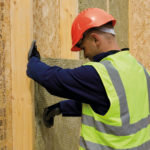Following the publication of the Heat and Buildings Strategy in October and with proposed changes to Approved Document L in England on the horizon, what do local authorities need to think about when it comes to insulation and what is its role on the road to net zero? Paul Barrett, Head of Product Management at ROCKWOOL UK explores.
Without a doubt, heat pumps and the proposed approach to gas boilers grabbed headlines following the publication of the Heat and Buildings Strategy. However, the policy paper released by the Department for Business, Energy and Industrial Strategy states: ‘Improving the energy efficiency of the fabric of the building, the appliances used, and the heat distribution system will reduce wasted energy and therefore reduce carbon emissions.’
Despite the fabric of a building being first in this list, it could be viewed that a home’s material construction and specifically its insulation have been somewhat overlooked in the narrative. Yet to enable technologies such as heat pumps to have the intended impact on carbon emissions, we must begin with a whole house, fabric first approach for reducing energy usage in the first instance. Or, where new technologies are retrofitted, make sure they are placed within a building fabric that’s highly effective so that their benefits can be realised.
To reduce carbon emissions, reduce energy usage, whilst also reducing energy costs, and maintaining indoor comfort, those responsible for public housing will need to take the lead on an integrated approach which firmly recognises that the fabric of the building must provide a high standard of insulation which performs consistently and effectively in use.
Starting with the fabric
Encouragingly, the proposed legislative changes help drive a fabric first approach with a focus on build quality. Changes to Approved Document L (ADL) in England act as a stepping-stone to the Future Homes Standard, stating that all new buildings must be designed to produce 31% less carbon emissions than those built to Part L1A (2013). Significant updates to minimum standards for work on existing dwellings are also anticipated.
The changes proposed to ADL in the Government’s preferred option, a ‘fabric plus technology’ approach, will target both the heating system and fabric of a new building. The proposed removal of the Fabric Energy Efficiency Standards (FEES) in the new Part L has been dropped, and this fabric first approach will remain be a significant feature of future legislation.

Building better
Born out of a need to close the gap between designed and as-built performance, a further change with ADL will be greater scrutiny of build quality. In England, this will manifest itself as the introduction of a Buildings Regulations England Part L (BREL) report, along with the need for photographic evidence of compliance. While this visual documentation will support local authorities in driving up standards, performance gaps often occur in areas that can’t be seen, thus we need more stringent monitoring of the build quality and, in particular, properly installed insulation to ensure the required performance is achieved.
To fully realise net zero carbon by 2050 — as the Future Homes Standard hopes to in part achieve — local authorities and their contractors will need to do more to ensure buildings perform well into the future and key to that is the effective specification, installation and monitoring of a robust insulation solution that provides continuity of performance.
Continuity for compliance
The first step in achieving this designed performance is to be certain that insulation is fitted contiguously and without gaps. Stone wool insulation makes this process easier as it is highly pliable so can be closely friction fitted to frames, without the need for impractical levels of precision cutting. This simplicity minimises the margin for error, supporting reliable and effective thermal performance that reduces thermal bridging.
This process also applies to abutments between insulation boards, another area that can be prone to thermal leakage. The composition of stone wool insulation allows individual slabs to knit together to create a seamless fit and the workable nature of stone wool insulation supports the delivery of designed U-values.
 For continuing performance, dimensional stability is key. Buildings can naturally expand and contract over time, which can lead to the formation of gaps and voids. Stone wool maintains its shape and properties over time across a wide range of temperatures, and has the resilience to accommodate building movement when fitted under compression. It has a proven ability to provide consistent performance — shown by tests even after 55 years in use — without a drop in its thermal properties.
For continuing performance, dimensional stability is key. Buildings can naturally expand and contract over time, which can lead to the formation of gaps and voids. Stone wool maintains its shape and properties over time across a wide range of temperatures, and has the resilience to accommodate building movement when fitted under compression. It has a proven ability to provide consistent performance — shown by tests even after 55 years in use — without a drop in its thermal properties.
The bigger picture
By achieving a well performing building fabric, the carbon savings that local authorities can deliver are significant. According to independent calculations by the Energy Savings Trust, fitting cavity wall insulation could save up to 505kg of CO2 per year based on the combined average for a semi-detached, mid-terrace home or a detached bungalow. Showing the potential impact of positive action, multiply this saving by the 1.58m homes managed by local authorities in England, half of which may not have sufficient cavity wall insulation, and the savings are nearing 400 million kilograms of carbon annually.
While the road to net zero is undoubtedly challenging, starting with the fundamentals of a well built home is a significant step on the journey and one within easy reach.









